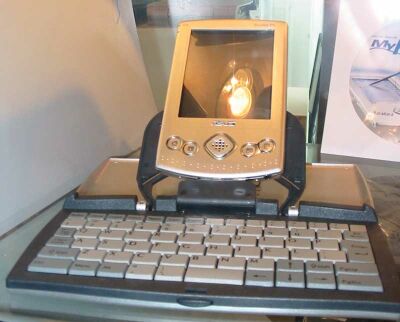Iedereen kent Asus natuurlijk als maker van moederborden en grafische kaarten. Daarnaast maken ze ook cd-writers, DVD-drives, notebooks en andere producten. Op de site van AnandTech kunnen we lezen dat Asus zich nu ook op de PDA markt gaat concentreren met de MyPal A600. Deze PDA is voorzien van de Intel XScale CPU, de opvolger van de StrongARM. Als besturingssysteem heeft Asus gekozen voor PocketPC 2002 van Microsoft. De MyPal A600 heeft bijna dezelfde afmetingen als een Palm M515 en is hiermee een stuk kleiner dan de Compaq iPaq H3870. Alleen de Toshiba e310 is nog kleiner. Een kleinere PDA neem je makkelijker overal mee na toe en Asus scoort hier dus een pluspunt.
Maar draagbaarheid is niet het enige wat telt. Het is natuurlijk ook belangrijk dat de batterijen lang meegaan. Op het eerste gezicht wint de iPaq het hier van de MyPal die een kleinere capaciteit batterij heeft. Maar door gebruik te maken van een in-huis geschreven stukje software weet de MyPal het toch langer uit te houden dan de Compaq. Dit stukje software, bijgestaan door hardware, kan de frequentie en het voltage van de CPU dynamisch aanpassen. Dit is vergelijkbaar met PowerNow van AMD. De meeste PDA gebruikers onder ons weten dat de backlight van een PDA veel stroom vreet. De A600 heeft hier een oplossing voor proberen te vinden door witte leds te gebruiken in plaats van de gebruikelijke fluorescent backlight. Volgens een benchmark van Microsoft die batterijverbruik meet, haalt de PDA van Asus vier uur met het backlight aan en de iPaq maar twee uur.
Op papier lijkt Asus met de MyPal A600 een winnaar in huis te hebben. Het blijft dus wachten op de eerste reviews om hier zeker van te zijn. Asus zit echter niet stil en liet AnandTech hun toekomstplannen weten:
On top of all the interesting stuff we heard about the MyPal A600, we were also told a bit about ASUS' next generation PDA. ASUS promised that the company's third generation PDA will be even more revolutionary than the MyPal A600. The company hopes to continue the trend they seem to be setting with their current PDA solution by making the third generation product a leader for PDAs everywhere. Things were pretty tight lipped about the upcoming product, but it seems that it will be using a transitive reflective screen which should further aid in saving battery life. This is because current reflective screens must be side lit and as a result about 65% of the light produced by the backlight does not hit the screen and instead bleeds into the environment. Implementing a transitive reflective screen would allow ASUS to mount the backlight behind the LCD panel, ensuring that every nit of light used goes directly into lighting the screen.
We were also told that the next generation PDA will include some sort of hardware to aid in video playback. Whether this will be a hardware based MPEG-2 decoder or even an MPEG-4 decoder, we do not know. What we do know is that such as solution has the potential to bring high quality video to PDA devices.
We also heard that the next generation product will include more features in the same form factor. ASUS mentioned the possibility of integrating 802.11b wireless connectivity, although maintaining battery life with integrated wireless is a problem they are still trying to figure out.


:strip_exif()/i/1009112102.jpg?f=thumbmedium)